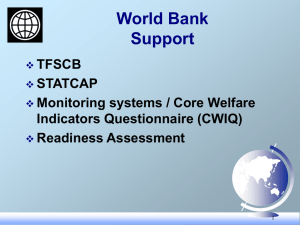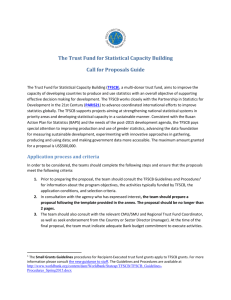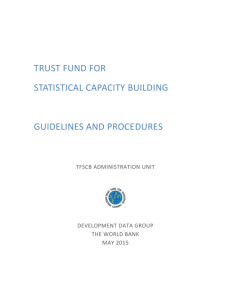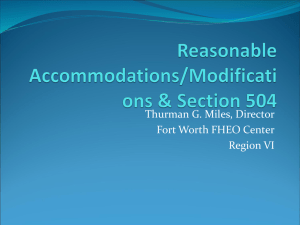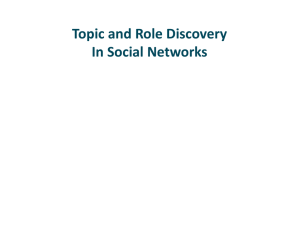TFSCB Guidelines and Procedures
advertisement
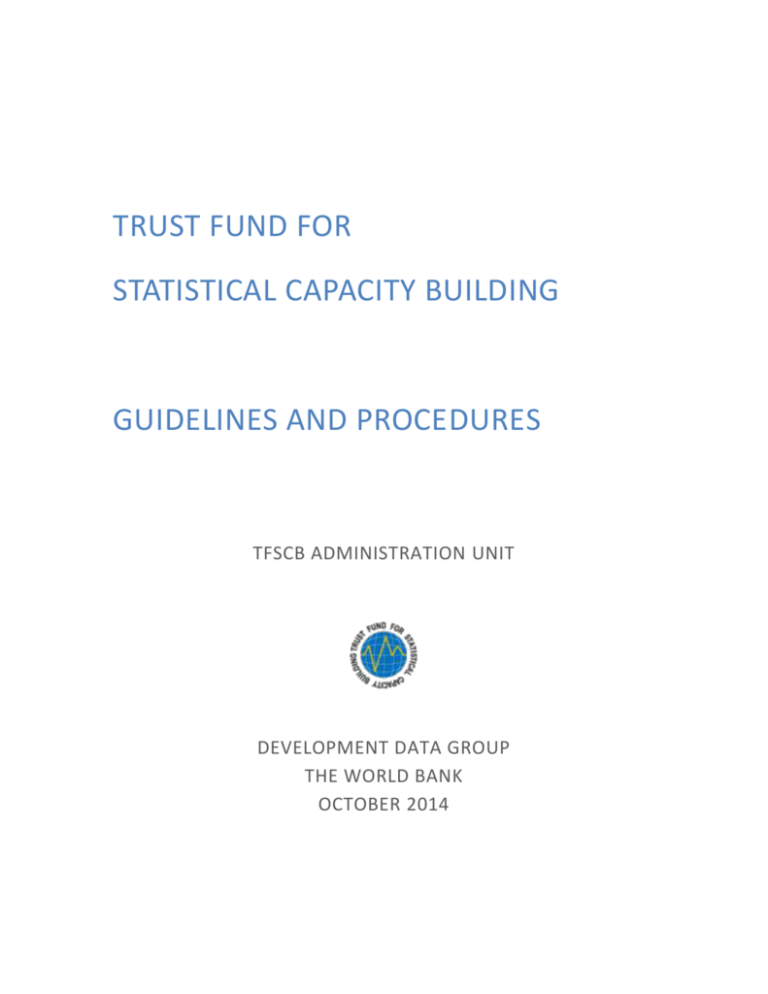
TRUST FUND FOR STATISTICAL CAPACITY BUILDING GUIDELINES AND PROCEDURES TFSCB ADMINISTRATION UNIT DEVELOPMENT DATA GROUP THE WORLD BANK OCTOBER 2014 TRUST FUND FOR STATISTICAL CAPACITY BUILDING (TFSCB) GUIDELINES AND PROCEDURES The purpose of these guidelines is to help task teams prepare TFSCB funding proposals. TFSCB proposals are expected to be self-contained and should provide all the necessary information for a full consideration of the funding request. OVERVIEW OF TFSCB PURPOSES OF THE TFSC B The Trust Fund for Statistical Capacity Building (TFSCB), a multi-donor trust fund, was established in 1999 by the Development Data Group of the World Bank to strengthen the capacity of statistical systems in developing countries. It is closely coordinated with the work of the Partnership in Statistics for Development in the 21st Century (PARIS21) and is part of the worldwide effort to reduce poverty by strengthening the evidence base for decision-making at all levels. In coordination with national governments and development partners, the TFSCB provides a practical mechanism to achieve the PARIS21 vision; that is, to develop effective and efficient national statistical systems and to promote a culture of evidence-based decision-making. In 2011 the Busan Action Plan for Statistics (BAPS) was approved at the Fourth High-Level Forum on Aid Effectiveness held in Busan, Republic of Korea. The BAPS builds on the Marrakech Action Plan for Statistics (MAPS), which has been in place since 2004. It puts particular emphasis on integrating national statistical activities with national planning, promoting open access to statistics and increasing knowledge and skills needed to use statistics effectively. Consistent with the BAPS and the needs of the post-2015 development agenda, the TFSCB pays special attention to improving the production and the use of gender statistics, advancing the data foundation for measuring sustainable development, experimenting with innovative approaches in gathering, producing and using data; and making government data more accessible. The TFSCB helps countries put BAPS into effect, ensuring that financing to improve statistical activities is robust and flexible. The TFSCB finances two main kinds of projects. The first type supports the preparation of National Strategies for the Development of Statistics (NSDS). The TFSCB works with PARIS21 to ensure that all low income countries have an integrated and comprehensive plan for the strategic development of their national statistical systems. The purpose of an NSDS project is to define a national long-term strategy to develop an efficient and sustainable statistical system in the recipient country. Strategies will differ from country to country due to differences in the political and cultural environment, the administrative structure (e.g. federal or centralized) and economic situation. An NSDS should be adopted at the highest political level after having reached a consensus among all stakeholders of the statistical system. PARIS21 2 has developed guidelines and recommendations for the production of NSDSs and these should be used wherever possible1. The second type of project (non-NSDS project) supports capacity-building activities in specific priority areas. For instance, these projects may target the implementation of one or more critical components of an NSDS. Non-NSDS projects are expected to be based on a formal assessment of the statistical system (Open Data implementation projects should be based on the ODRA report and action plan) and must demonstrate how they will address the main capacity weaknesses. If a country does not have an NSDS or ODRA it is strongly encouraged to prepare one before applying for a non-NSDS or OD implementation project. Project proposals are required to set out specific targets for capacity development. The resources provided must be additional and cannot be used simply to replace national budgetary resources. For example, while it may be possible to use funds to meet some of the costs of data collection activities, especially where new activities are being tried out, projects that are just concerned with maintaining existing systems are unlikely to be approved. In all proposals, recipients are required to demonstrate their commitment to the project by providing some contribution to the overall cost, which may be a monetary or in-kind contribution. KEY FEATURES OF TFSCB Aims to achieve the PARIS21 vision and is a key component in supporting the implementation of the Busan Action Plan for Statistics. Foster evidence-based policy making and effective monitoring. Promotes a strategic approach to the development of statistical capacity, supporting the preparation and implementation of nationally prepared and owned strategic statistical development plans. Provides an intervention mechanism to help initiate changes in policy and decision-making through improved availability and use of information and statistical data. Most projects operate at the national or sub-national level, but the trust fund can also support regional and global projects where there is a case for intervention at this level. Improves the use of resources for development through better-informed decision-making resulting from improved statistical systems and hence better data quality and analysis. Promotes partnerships and improves coordination among local and international agencies and civil society organizations. USES OF THE FUND 1 The TFSCB finances two kinds of projects as outlined above: those concerned with the preparation of an NSDS; and other, non-NSDS projects that aim to strengthen capacity in key priority sectors such as gender statistics, administrative data sources, Open Data projects, and post-MDG 2015 indicators. Projects should also be results-oriented and promote partnerships and knowledge sharing. The latest version of the PARIS21 NSDS Guidelines, “NSDS 2.0”, is available here. 3 TFSCB grants may be used either to finance country-based activities or global or regional programs. However, TFSCB grants cannot be used to supplement the administrative or logistical needs of these projects. Regional and global projects will only be financed where there is a clear case of intervention at this level and where a single implementing agency is identified. In general, regional projects will be linked to the follow up of PARIS21 regional workshops. It is also important to note that the Trust Fund has been set up to build statistical capacity and not simply to fund data collection activities. Applications must indicate where there are presently capacity weaknesses in the statistical system and how the proposal will address them. ILLUSTRATIVE ACTIVITIES In light of the above discussion of statistical capacity building, the following is an illustrative list of activities, which might be proposed for financing under TFSCB. (A) FOR NSDS PROJECTS Supporting the preparation of an NSDS is a major activity of the TFSCB. More detailed information on good practice in the preparation and implementation of NSDS can be found on the PARIS21 website. In summary, the process is expected to involve the following steps: A detailed assessment of the current statistical system, for example, using an assessment framework such as the GDDS or DQAF, identifying strengths and weaknesses and looking at all aspects of activities from the quality of the output to aspects such as finance and management. An identification of all of the main stakeholders in the statistical system and the establishment of processes and procedures for regular consultation. The development of a medium-term strategic vision, setting out where the statistical system expects to be within the next five to ten years. The identification of the main priority actions that will be needed to address the weaknesses and achieve the vision. This will generally address at least five areas, including: the regulatory and managerial framework, statistical infrastructure, statistical operations and procedures, human resources, and physical infrastructure. Putting together a detailed implementation or master plan, with a time-bound and budgeted set of actions, identifying what will need to be done and when. Establishing an implementation mechanism, including a financing plan, mechanisms for monitoring and reporting on progress at regular intervals, and a process for review and evaluation. A well-developed NSDS could provide a basis for a larger, more comprehensive project - for instance financed by a STATCAP lending operation. 4 (B) FOR NON-NSDS PROJECTS Non-SDS projects can support activities to strengthen statistical systems at sub-national, national, regional, and global levels; including but not limited to improvements in the following areas: Management, institutional framework and coordination; Data user-producer dialogue; Human resource capacity, including training; Statistical methodologies; Data processing and management methods; Data quality; Dissemination of comprehensive, timely, accessible, and reliable economic, financial, and sociodemographic statistics; Openness and accessibility of data that could be achieved through improving data integrity, accessibility to data by the public, and accessibility formats2; Development of a framework for evaluating needs for data improvement and setting priorities in this respect; National capacity for poverty analysis; Sector-specific capacity improving activities; Special areas of economic and socio-demographic statistics such as environmental accounting and gender statistics; Data foundation for measuring sustainable development; and Development of innovative approaches in data collection, processing and dissemination. HOW TO APPLY Project proposals funded by the TFSCB may originate from a number of different sources, including statistical agencies of member countries and international and regional development organizations. It is highly recommended that agencies interested in preparing an application should make early contact with the TFSCB Administration Unit or the local World Bank office. For each project, the World Bank will nominate a Task Team Leader (TTL), who will liaise with the implementing agency, and take responsibility of supervision of the project to ensure compliance with the fiduciary requirements of the World Bank. Once the Recipient and the World Bank have agreed to apply for a TFSCB grant, the task teams must complete the two steps described below. 2 TFSCB grants can finance open data readiness assessments (ODRA) and technical assistance and training for ODRA implementation, depending on the country's needs and requests for support. Country-specific grant proposals for ODRA implementation must include the ODRA report and action plan in the grant proposal. ODRA implementation grants for IBRD countries will have higher expectations in terms of 3 metrics: quality of the OD portal, number of datasets included in the OD portal, and number of data uses (apps, visualizations, data mash-ups, or similar). 5 Please note that Stage 1 only applies to non-NSDS projects. NSDS proposals are accepted on a rolling basis and therefore can skip Stage 1 and proceed directly to Stage 2. STAGE 1 1. 2. 3. 4. 5. Prior to preparing a proposal, the team should consult the TFSCB Guidelines and Procedures for the program objectives, the activities typically funded by TFSCB, the application conditions and selection criteria. In consultation with the agency which has expressed interest, the team should prepare a proposal following the template provided in Annex 1. The proposal should be no longer than 2 pages. The team should consult the CMU/SMU and Regional Trust Fund Coordinator, as well as seek endorsement from the Country or Sector Director (manager). At the time of the final proposal, the team must indicate adequate Bank budget commitment to execute the grant activities. The proposal should be submitted by TFLAP accredited Bank staff to the TFSCB Administration Unit (iivins1@worldbank.org and mdinc@worldbank.org) as an attachment via email. The deadline to submit proposals is indicated in the latest call for proposal guide posted on the TFSCB website (http://www.worldbank.org/en/data/statistical-capacity-building/trust-fund-forstatistical-capacity-building). Proposals will be reviewed and shortlisted by the TFSCB Administration Unit based on the fit with the objectives and priorities of TFSCB and the available resources. The task team leaders (TTL) of shortlisted proposals will be notified. STAGE 2 1. 2. 3. 4. 5. 6. The Recipient (agency), in consultation with the TTL, will send a formal letter of request to the Bank addressed to the appropriate Country Director or Sector Director (Manager), to apply for TFSCB Grant funds for a particular project that falls within the parameters of the TFSCB guidelines. The designated TTL in consultation with the Recipient completes the TFSCB application in GFR (see Annex 2). It is recommended that the TTL send the draft proposal to the Administration Unit for comment before formally submitting a proposal on GFR. For a country-specific proposal, the TTL seeks endorsement from the Country Director or Sector Director (Manager). For a regional/global proposal, the TTL seeks endorsement from the relevant Sector Director (Manager) and where necessary from the concerned Country Directors. This will assure the allocation of required resources for supervision and management of the project. The approval must be obtained through the GFR. The TFSCB Internal Management Committee (IMC) reviews the proposals, ensuring that they are consistent with TFSCB guidelines and procedures, and makes one of three decisions: i) approved (with no or minimal revision); ii) revisions and re-submission; or iii) rejection. Revisions and resubmission must be completed within 2 months from the date of the decision. The Chair of the IMC sends the decision to the TTL and the approving manager. Post-approval procedures are indicated in Annex 3. 6 APPLICATION CONDITIONS AND SELECTION CRITERIA APPLICATION CONDITIONS The following conditions are requirements for all projects to be financed from the Trust Fund. All member countries of the World Bank are eligible for the TFSCB funding; however, IDA countries will have priority. All TFSCB funded activities should be compatible with national and regional development objectives as set out in Poverty Reduction Strategy Papers, World Bank Country Assistance Strategy reports, and other strategy documents and should be in line with and support the PARIS21 consortium, the World Bank and other donors' poverty reduction and MDG-related activities. All projects financed under TFSCB should be demand driven (demonstrated through an official request letter from recipients) to contribute to the development of the statistical system of the recipient country and should not be used to cover the administrative or logistical cost of these projects. All non-NSDS country proposals should indicate how they relate to the national statistical development strategy. Priority will be given to projects that are based on an existing national statistical strategy and which are in line with the priorities already identified. In countries without an NSDS, non-NSDS projects will only be financed where there is a clear justification of the need for immediate capacity building before an overall strategic framework can be developed and where the project will contribute to the development of a more strategic approach to official statistics. In line with the overall PARIS21 approach, coordination with other development projects must be set out in detail. TFSCB funded projects should promote coordination and collaboration with local and international agencies, civil society and NGOs, help to develop partnerships, and to strengthen mechanisms to share knowledge and experiences. TFSCB funded activities should focus on the most urgently needed components that will make most direct impact on the statistical system, and so eventually improve policy and decision making and monitoring. For non-NSDS projects in particular, priority will be given to projects that are innovative and are unlikely to be financed from other sources. Applications should indicate what other funding sources, if any, have been approached to finance the project and what the response has been. Project proposals may originate from a number of different sources, including staff from national statistical agencies and other data providers (i.e. sectoral) and users as well as staff and/or consultants from donor agencies. However, all proposals should define the ways in which the project is linked to the national statistical system and specify how activities will be coordinated. TFSCB financed projects are to be implemented by an appropriate national or regional agency that may be a government department, a civil society organization or other national or regional agency. Projects may also be implemented by third parties such as donor agencies or, in 7 exceptional circumstances as explained in OP 14.40, by the World Bank itself on behalf of the grant recipient (BEBR). All implementing agencies must be able to sign legal contracts and should demonstrate financial soundness and a capacity to manage and account for funds. Implementing agencies are required to follow World Bank standard procedures for procurement, disbursement and accounting. For each project the Bank will nominate a Task Team Leader, who will take responsibility for liaison with the implementing agency, supervision and ensuring compliance with trust fund procedures. Proposals should define the mechanisms planned for identification, establishment and monitoring of priority beneficiaries, and arrangements to ensure that the proposed interventions will reach the targeted beneficiaries. Proposals should provide assurance of proper project execution, including the necessary resources for supervision and management, and should provide for the standard level of World Bank Group accountability and oversight for such activities. Proposals should list performance indicators to monitor and evaluate the proposed activities, including measures of implementation progress and the outcome or impact. They should describe the performance monitoring and impact evaluation systems that would be used or established for these purposes. The maximum budget for any one proposal is US$ 500,000 and the maximum duration is two years, with a possibility of one year extension. For NSDS proposals the upper limit is determined case by case based on the size and the needs of the recipient country, but past experience suggests that most projects require much less support and are normally completed within one year. Procurement of goods is allowed in Recipient Executed grants only; and the maximum amount allocated for goods cannot exceed 20% of the grant amount. CRITERIA FOR SELECTION All project proposals will be reviewed to ensure that they satisfy the basic conditions as outlined above. Projects will then be assessed by the Internal Management Committee using the following criteria. (A) FOR NSDS PROJECTS The quality of the approach proposed to develop a National Strategy for the Development of Statistics, and the extent to which this is in line with good practice as set out, for example, by PARIS21. The effectiveness of the mechanisms proposed to ensure consistency and alignment with the PRSP or other national strategy, and MDG monitoring processes. The feasibility of the timetable and the adequacy of the budget. The quality of the consultative and participatory process proposed involving both data users and producers and the extent to which the views of the key stakeholders have been and will be taken into account. 8 The level of commitment to the process demonstrated by government and other stakeholders, including other donor agencies, as demonstrated, for example, by the level of contributions in cash and in-kind. The adequacy and feasibility of the mechanisms proposed for project management and supervision. The adequacy of the reporting process and the monitoring indicators proposed. (B) FOR NON-NSDS PROJECTS The extent to which the project is in line with the priorities identified in the NSDS, or where such a plan does not yet exist, the extent to which the project will lead to a more strategic approach to statistical capacity building. The extent to which the approach proposed is in line with internationally accepted good practice and recommendations. The need and suitability of the project for funding from this global trust fund; innovative projects that are unlikely to be financed from other sources will have priority, provided they are assessed to be technically feasible and financially sound. The feasibility of the timetable and the adequacy of the budget. The quality of the consultative and participatory process proposed and the extent to which the views of the key stakeholders have been and will be taken into account. The level of commitment to the process demonstrated by government and other stakeholders, including other donor agencies, demonstrated, for example, by the level of other contributions in cash and in-kind. The adequacy and feasibility of the mechanisms proposed for project management and supervision. The adequacy of the mechanisms proposed to monitor and evaluate progress and to report to stakeholders. CONTACTS For further information and questions, please contact Ingrid Ivins (iivins1@worldbank.org; 202-473-2737) or Mustafa Dinc (mdinc@worldbank.org) in the TFSCB Administration Unit. You can also visit http://www.worldbank.org/en/data/statistical-capacity-building/trust-fund-for-statistical-capacitybuilding. 9 ANNEX 1: TFSCB PROPOSAL TEMPLATE (STAGE 1) A. BASIC INFORMATION Proposal Title Country/Region Task Team Leader Name Other team members (if applicable) Managing Unit Country/Sector Manager Name Endorsed by Manager Proposed Grant Amount (USD) Implementing Agency Partners (if applicable) Yes/No B. PROPOSAL DETAILS What are the development objectives of the project? How is the project linked to the national strategy for the development of statistics (if this is a global or regional project, please also specify the name of the strategy)? How is the project related to the Bank policy and strategy (as defined in Country Assistance Strategy, sector strategy and/or other relevant document)? Please provide a summary description of project activities. Please provide expected outputs and outcomes (what will change as result of the proposed activities) of the project. 10 What are the mechanisms to ensure sustainability and the follow up activities? C. BUDGET Please provide the estimated budget of the project. Project component Expenditure category (choose one) Consultants/Training/Goods Total 11 Amount (USD) ANNEX 2: TFSCB GRANT FUNDING REQUEST (GFR) TFSCB Brief GFR Guidance 1) If you are not familiar with the GFR system, please refer to the “resources” section available at: http://gfr. System related questions should be addressed to eTF Query at x38510. 2) The TTL needs to provide necessary information in the attachments. (Budget table and other information as specified as well as a letter of request from the recipient.) 3) Please provide the Project ID before submission (a new Project ID may need to be created). 4) Please note that this request needs to be approved by either a Sector Director or the Country Director before submission. 5) In the description tab, question 2, please specify project components (objectives, proposed activities with costing, and expected outputs and outcomes). TFSCB Required GFR attachments TFSCB website Required Information (Fill in this section first) Grant/Child TF Name* Funding Window* Country: Name of the proposed project (not TFSCB) 3663 TRUST FUND FOR STATISTICAL CAPACITY BUILDING - III Team Leader* Grant Curr/Amount* USD Equivalent USD Est. Grant Start Date* Execution Grant Closing Date * Bank Executed Recipient Executed Financial Intermediary Funds Implemented by (Agency)* Grant Linked To* Process (I/O) ID Project (PO) Name Country* Grant Type * 12 Product Line: TF Usage * Description Comments/Requests by Team Leader Please provide any additional information that can be helpful for the TFSCB Internal Management Committee. What is the Development Objective (or main objective) of this Grant?* Summary description of Grant financed activities (text may be used in the Grant Agreement)* Please make sure to include project components with objectives, proposed activities with estimated cost, expected output and outcomes in this section. Grant Activity Risk Rating* What are the main risks related to the Grant financed activity? Are there any potential conflicts of interest for the Bank? How will these risks/conflicts be monitored and managed?* Describe any significant environmental or safeguard issues related to this Grant and how they will be addressed? To what extent are these issues covered in the ISDS for the project supported by the Grant? * (Optional question) What can/has been done to find an alternative source of financing, i.e. instead of a Bank administered Grant? TFSCB Specific TFSCB Classification and Ratings Has the recipient received any other TFSCB grants?* TFSCB Specific Questions Please explain the linkage to the National Strategy for the Development of Statistics (NSDS) or the Statistical Master Plan.* 13 Please explain the recipient's commitment and ownership.* Please explain the sustainability of the project and provide supporting evidence.* How is the Grant related to Bank policy and strategy (as defined in Country Assistance Strategy and/or other relevant documents)?* How is the Grant related to other projects financed by the Bank and other financiers/donors?* Grant execution and implementation arrangements: How will the Grant be managed and supervised? If Bank executed, please specify.* If the Bank execution is proposed for recipient activities please make sure to attach a request letter from the recipient and provide necessary justification 14 GRANT FINANCING PLAN [insert GFR # and country/project name] Resource TFSCB Recipient Other sources (please identify) Amount (USD) Total BUDGET TABLE Components 1. Component description Category (pick one) Number Duration Unit rate Cost TFSCB Other Sources Goods /services/ training 2. … Total cost COST CATEGORIES Summary Costs by Category Total (USD) Goods (max 20 per cent of grant amount) Services Training Total Costs TIMETABLE Activity 1. 2. ... Number of months from grant approval Note: These tables can also be submitted in Excel format. 15 Total ANNEX 3: TFSCB POST-APPROVAL PROCEDURES POST-APPROVAL PROCEDURES 3 LEGAL AGREEMENT AND ACTIVATION The Procedures for Small Recipient-Executed Trust Fund Grants, effective April 2012 and updated July 28, 2014, apply to all TFSCB projects. Once the project proposal is approved in the GFR, the TTL is advised to contact the relevant lawyer to determine whether the grant agreement will be prepared by the TTL (using the small grants template) or by the lawyer. Regardless of who prepares the grant agreement, the lawyer, the finance officer, and the TFSBC Administration Unit (iivins1@worldbank.org; mdinc@worldbank.org) should be copied on all exchanges related to the preparation of the legal documents so as to enable them to intervene as needed. Under all circumstances, the final draft grant agreement should be cleared by LEG prior to its signing. Once a grant TF account number is generated, the TTL, in consultation with CTRLD staff, and if needed the assigned FM and PR specialists, completes the Disbursement Letter using the standardized template for small grants. The completed disbursement letter is sent to the Recipient together with the grant agreement as a single package. The TTL prepares execution copies of the Grant Agreement and Disbursement Letter and arranges for signature by the Bank country director (or, for global grants, the relevant Network/Sector director) and the recipient. Unless there are additional conditions of effectiveness, including the recipient’s requirements for parliamentary approval or ratification, for example, the Grant Agreement becomes effective once it is countersigned by the recipient. The Grant Agreement and the Disbursement Letter are signed in two originals, one for the Bank and one for the Recipient. The TTL obtains the original hard copy of the countersigned Grant Agreement and sends it along with the original signed Disbursement Letter to Official Documents in LEG, with an official transmittal memorandum based on a template provided by LEG. In addition, the TTL provides a pdf file of the countersigned Grant Agreement and Disbursement Letter to LEG, TACT, and CTRLD. Once a grant becomes effective, the recipient's authorized representative must provide the original specimen signatures of the recipient's authorized signatories for withdrawal applications. The original specimen signatures letter must be filed in Official Documents, normally done by LEG, before disbursements can be made. The TTL also provides a pdf file of the specimen signatures letter to LEG, CTRLD and TACT. TTLs should keep in mind that if there is no project activity within six months after the approval of the proposal, the IMC will review the situation and may decide to cancel the grant. IMPLEMENTATION AND SUPERVISION Once activated, the TTLs will be responsible for supervising the activities of this project. Please note that implementing agencies are required to follow standard World Bank guidelines and procedures regarding procurement, disbursement and accounting matters. 3 For more information on the post approval process, please refer to the Trust Fund Handbook and the Procedures for Small Recipient-Executed Trust Fund Grants: Guidance to Staff. 16 The TTL will be requested and must submit a Progress Report via the Grant Reporting and Monitoring (GRM) system twice a year. TTLs will be informed by a system generated email when the report is due. TRUST FUND TTL HANDOVER AND TRANSFER OF RESPONSIBILITY Whenever there is a change in the trust fund management, all TTL’s need to fill out the following two documents and file them in WB Docs under the relevant trust fund number: (i) Trust fund transfer of responsibility and handover note (see Annex 4 Trust Fund Transfer of Responsibility for a template); and (ii) Interim letter of representation4. CLOSING The TTL initiates action for closure when the activities financed by the TF are completed. For recipient-executed trust funds, after the Loan Department completes disbursements and advises the TTL of the account‘s final status, the TTL advises the recipient of the final disbursement position, and the cancellation of any balance. This notice is cleared with copies to LEG and the Loan Department, and copied to the relevant program manager. As soon as CTRDM (formerly LOADM) receives a copy of the final signed notice, CTRDM cancels any unused funds after which CTR (formerly ACT) finalizes closure of the trust fund and ensures that the unused funds are disposed of in accordance with the Administration and Grant Agreements. The TTL advises the Recipient of cancellation actions via the closing/cancellation notice. CTR (formerly ACT) arranges for any external financial statement audit required under the Administration Agreement(s). EXTENSION OF CLOSING DATE AND END-DISBURSING DATE The grant closing date may be extended if (i) the project objectives continue to be achievable, (ii) the performance of the borrower and other project implementing agencies is satisfactory, and (iii) the recipient has prepared a specific action plan 5 acceptable to the Bank to complete the project, and after consultation with the TF Program manager and/or TF donors (for stand-alone TFs) as needed. An extension may be approved for selected disbursements covering only part of a project to permit (a) implementation of high priority contracts; or (b) provision for retention payments, when the conditions for release are met after the closing date. Normally, an extension is granted for a maximum of one year with longer extensions allowed only when the recipient requires a firm commitment for continued Bank financing. The TTLs should also consult the applicable OP/BPs for specific details on exceptions to extension of closing dates. If the GRM is not up-to-date any request for an extension and/or allocation of funds will not be granted. 4 For more information on letter of representation (LoR), please visit the Partnership and Trust Fund Portal at http://go.worldbank.org/D9BVJLU6F0. 5 TTL revises the implementation schedule and agrees with the recipient on a written action plan that covers (a) the additional time needed to complete project implementation and disbursements, (b) any actions the recipient and/or project implementation agencies need to take to meet the revised closing date, (c) the actions required to achieve compliance with any loan covenants that have not been fully met, and (d) the monitorable performance indicators that will be used to determine compliance with this action plan. 17 RETROACTIVE EXTENSION Retroactive extension of closing and end-disbursement dates is always an exception. Once the date elapses and retroactive extensions are required: For Bank-executed trust funds, provided the proposed extension is within the boundaries of the trustee/Main level, the Program Manager may approve the retroactive extension. For recipient-executed trust funds (including grants which are executed by the Bank on behalf of the recipient), TTLs should consult their Regional or departmental quality or policy unit or OPCS Advisory Services, before formally processing requests for retroactive extensions of closing dates. The authority to approve retroactive extensions of closing dates for grants rests with the Vice Presidents of Regions or departments that manage such grants. 18 ANNEX 4: TRUST FUND TRANSFER OF RESPONSIBILITY THE WORLD BANK/IFC/M.I.G.A. OFFICE MEMORANDUM DATE: TO: mm/dd/yyyy Messrs/Mmes. FROM: EXTENSION: SUBJECT: Trust Fund Transfer of Responsibility and Hand-over Notes This is to confirm that as of mm/dd/yyyy, I am transferring the TF management responsibility of the following Trust Fund: TF Number TF Name TF-----Attached is a copy of the financial statement of the trust fund. This statement provides the new TTL with an assurance of the validity of the status of commitments and disbursements or expenses as of the date when she/he takes on the assignment. Furthermore, I confirm that I have briefed the person to whom responsibility is to be transferred and have given her/him all the necessary documentation, such as the legal agreement and/or proposal or request for the trust fund activity, outputs and any special guidelines that may apply to the above trust funds. Signature: _________________________ Name: ____________________________ Date: _____________________________ ------------------------------------------------------------------ For the New TF TTL: I confirm that I have been briefed by ------------------------------------------ and have reviewed the relevant TF documentation. I fully understand my fiduciary obligations in managing the abovementioned trust fund. Signature: _________________________ Name: ____________________________ Date: _____________________________ 19
